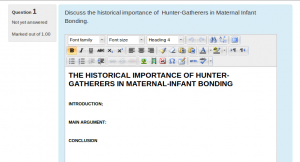Question types
You may add a variety of different types of questions in the Quiz and Lesson modules. This page is about Quiz module question types; some will be similar to Lesson questions types, which are fewer in number and function differently. The standard quiz question types are listed below with brief descriptions. Please use the links on the right side of this page to find more detailed information about standard questions types.
Standard question types
Calculated
Calculated questions offer a way to create individual numerical questions by the use of wildcards that are substituted with individual values when the quiz is taken. More on the Calculated question type
Calculated multi-choice
Calculated simple
Description
This question type is not acutally a question. It just prints some text (and possibly graphics) without requiring an answer. This can be used to provide some information to be used by a subsequent group of questions, for example. More on the Description question type
Essay
This allows students to write at length on a particular subject and must be manually graded.
New feature
in Moodle 2.5!
It is possible for a teacher to create a template to scaffold the student's answer in order to give them extra support. The template is then reproduced in the text editor when the student starts to answer the question. See Youtube video Essay scaffold with the Moodle quiz
Matching
A list of sub-questions is provided, along with a list of answers. The respondent must "match" the correct answers with each question. More on the Matching question type
Embedded Answers (Cloze Test / Gap Fill)
These very flexible questions consist of a passage of text (in Moodle format) that has various answers embedded within it, including multiple choice, short answers and numerical answers. More on the Embedded Answers question type
Multiple choice
With the Multiple Choice question type you can create single-answer and multiple-answer questions, include pictures, sound or other media in the question and/or answer options (by inserting HTML) and weight individual answers.
Short Answer
In response to a question (that may include an image), the respondent types a word or phrase. There may several possible correct answers, with different grades. Answers may or may not be sensitive to case. More on the Short Answer question type
Numerical
From the student perspective, a numerical question looks just like a short-answer question. The difference is that numerical answers are allowed to have an accepted error. This allows a continuous range of answers to be set. More on the Numerical question type
Random short-answer matching
From the student perspective, this looks just like a Matching question. The difference is that the sub-questions are drawn randomly from Short Answer questions in the current category. More on the Random Short-Answer Matching question type
True/False
In response to a question (that may include an image), the respondent selects from two options: True or False. More on the True/False question type
Third-party question types
Besides the standard question types that are part of the core Moodle distribution, there are a number of question type add-ons in the add-ons database.
Some of those add-ons have additional documentation in Third-party question types:

